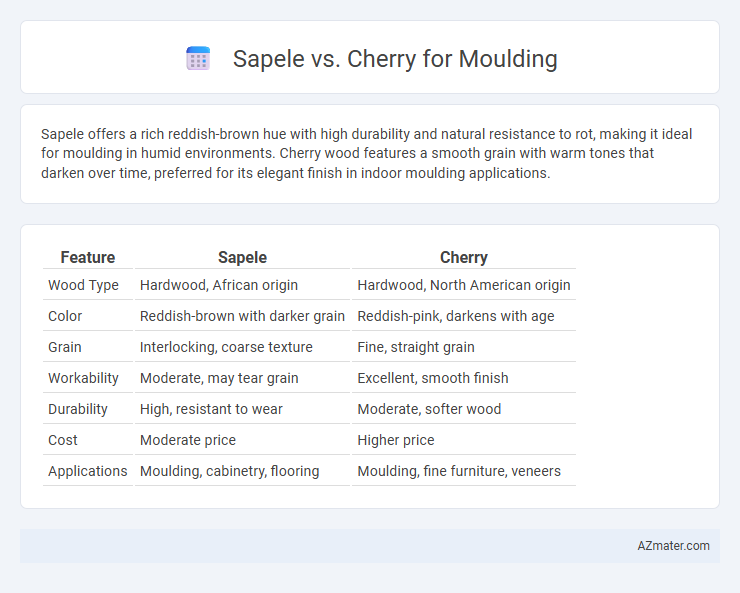Sapele offers a rich reddish-brown hue with high durability and natural resistance to rot, making it ideal for moulding in humid environments. Cherry wood features a smooth grain with warm tones that darken over time, preferred for its elegant finish in indoor moulding applications.
Table of Comparison
| Feature | Sapele | Cherry |
|---|---|---|
| Wood Type | Hardwood, African origin | Hardwood, North American origin |
| Color | Reddish-brown with darker grain | Reddish-pink, darkens with age |
| Grain | Interlocking, coarse texture | Fine, straight grain |
| Workability | Moderate, may tear grain | Excellent, smooth finish |
| Durability | High, resistant to wear | Moderate, softer wood |
| Cost | Moderate price | Higher price |
| Applications | Moulding, cabinetry, flooring | Moulding, fine furniture, veneers |
Introduction to Sapele and Cherry Woods
Sapele wood, a tropical hardwood from West Africa, features a rich reddish-brown color and a fine, interlocking grain that enhances its durability and resistance to wear, making it ideal for moulding applications requiring strength and aesthetic appeal. Cherry wood, native to North America, is prized for its smooth texture, warm reddish tones that deepen with age, and ease of shaping, providing a classic, elegant look for moulding in both traditional and modern interiors. Both woods offer unique characteristics that influence their performance in moulding, with Sapele providing robustness and Cherry delivering refined beauty.
Botanical Origins and Availability
Sapele, scientifically known as Entandrophragma cylindricum, is an African hardwood abundant in tropical West Africa, prized for its durability and straight grain, making it ideal for moulding. Cherry, or Prunus serotina, native to eastern North America, offers a finer grain and warm reddish hue but is less abundant due to controlled harvesting and slower growth. Availability of Sapele is generally higher due to vast West African forests, whereas Cherry tends to be more limited and costly because of regional demand and sustainability concerns.
Grain Patterns and Aesthetic Appeal
Sapele features a rich, reddish-brown color with a distinctive interlocking grain pattern that creates striking ribbon-like figures, offering a bold and elegant appearance ideal for moulding. Cherry showcases a smooth, fine grain with a warm, reddish tone that deepens over time, providing a classic and refined aesthetic. The choice between Sapele and Cherry for moulding depends on whether a more dramatic, textured look or a subtle, timeless appeal is desired.
Color Differences: Sapele vs Cherry
Sapele moulding showcases a rich reddish-brown color with subtle darker streaks, offering a warm, exotic appearance compared to Cherry's more uniform light to medium reddish-pink hue that deepens to a rich reddish-brown over time. The color evolution in Cherry moulding adds character as it ages, while Sapele maintains a consistent rich tone with less noticeable color change. Choosing between Sapele and Cherry for moulding depends on whether a stable, tropical aesthetic or a dynamic, aging warmth is desired.
Workability and Machining Properties
Sapele offers excellent workability with a fine, consistent grain that responds well to both hand and machine tools, resulting in smooth finishes and minimal tool wear. Cherry exhibits superior machining properties, cutting cleanly with sharp edges and producing minimal tear-out, making it ideal for intricate moulding details. Both species provide good stability, but Sapele's interlocked grain can sometimes cause slight difficulty in planing compared to the more uniform grain of Cherry.
Durability and Resistance to Wear
Sapele wood is known for its high durability and resistance to wear, making it an excellent choice for moulding in high-traffic areas due to its dense grain structure and natural oils that protect against moisture and decay. Cherry wood, while moderately durable, is softer and more prone to dents and scratches over time, although it offers a smooth finish and rich color that deepens with age. For applications requiring long-lasting wear resistance, Sapele outperforms Cherry, especially in environments subject to frequent impact and abrasion.
Finishing Characteristics
Sapele offers a rich, reddish-brown hue with a natural luster that deepens over time, providing a smooth and consistent finish ideal for moulding. Cherry wood is prized for its warm, pinkish tone that darkens to a rich reddish-brown with age, resulting in a velvety smooth finish that enhances fine details in moulding. Both woods sand well and accept stains evenly, but Cherry often achieves a more polished, luxurious appearance with a subtle sheen compared to Sapele's slightly more textured finish.
Cost Comparison and Market Value
Sapele moulding generally costs less than Cherry due to its abundant availability and lower harvesting expenses, making it a budget-friendly option for large projects. Cherry moulding commands a higher price in the market because of its rich color, fine grain, and high demand in luxury cabinetry and millwork. The market value of Cherry remains consistently strong, often appreciating over time, whereas Sapele's value is more moderate and dependent on regional supply.
Environmental Impact and Sustainability
Sapele, sourced from West African rainforests, poses concerns due to deforestation and habitat loss, despite certification efforts like FSC promoting sustainable harvesting. Cherry, native to North American forests, typically comes from managed woodlands with higher reforestation rates, making it a more sustainable option for moulding projects. Choosing Cherry mouldings often supports lower carbon footprints and enhanced ecosystem preservation compared to Sapele.
Best Applications: Choosing the Right Wood for Moulding
Sapele offers exceptional durability and a rich reddish-brown hue, making it ideal for high-traffic areas and exterior moulding applications requiring resistance to wear and moisture. Cherry wood, known for its fine grain and warm, reddish tones, excels in interior moulding where aesthetic appeal and smooth finishes are prioritized. Selecting between Sapele and Cherry depends on balancing durability needs with desired visual characteristics for optimal moulding performance.

Infographic: Sapele vs Cherry for Moulding
 azmater.com
azmater.com